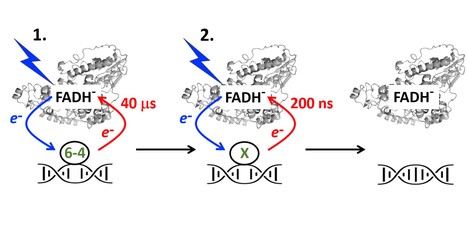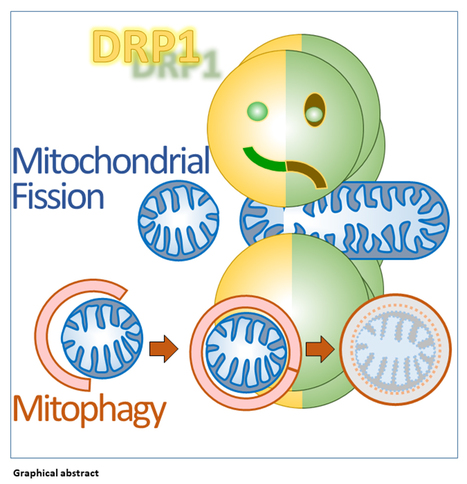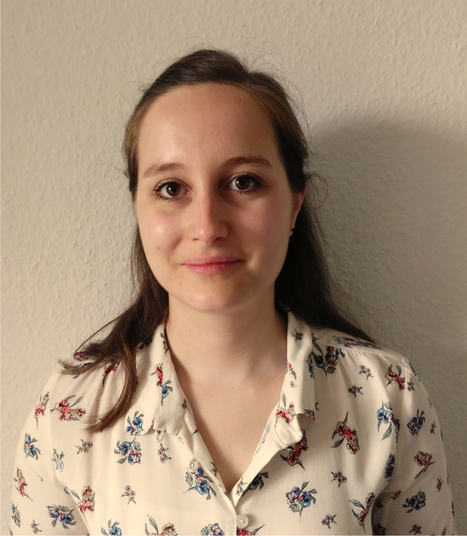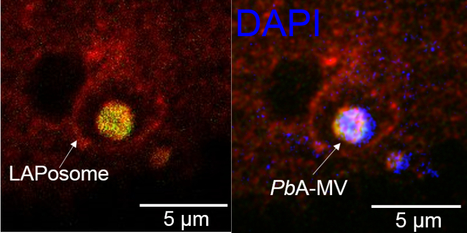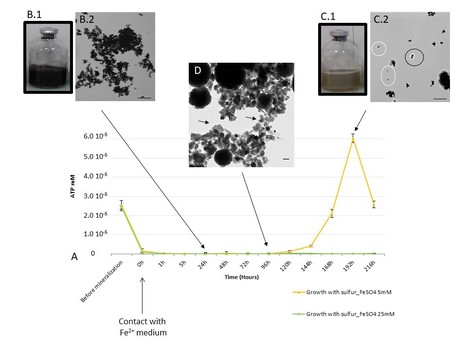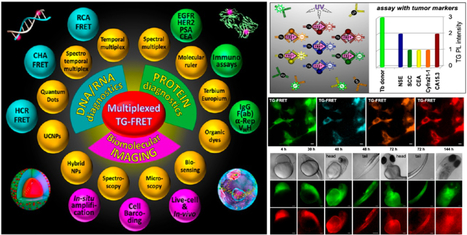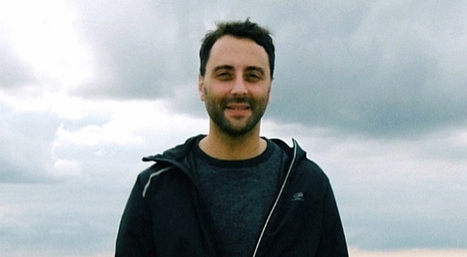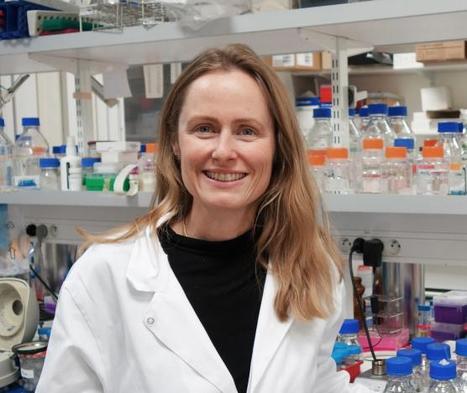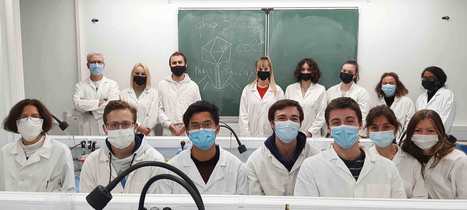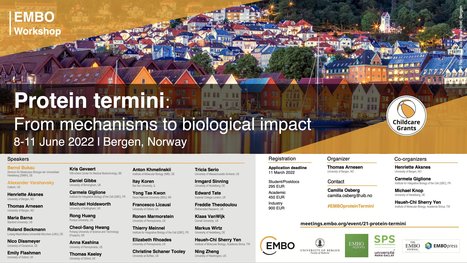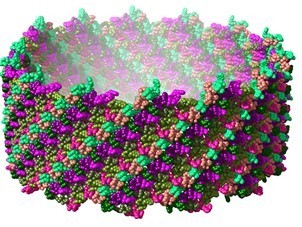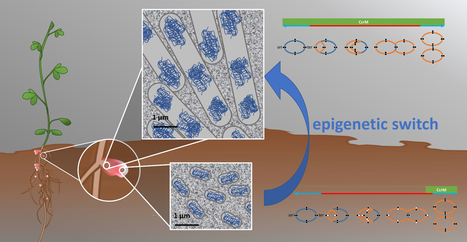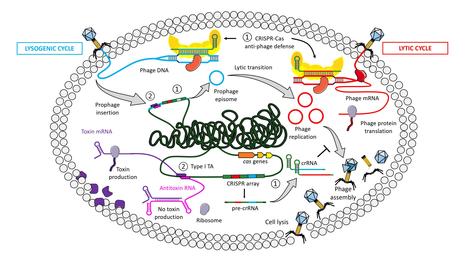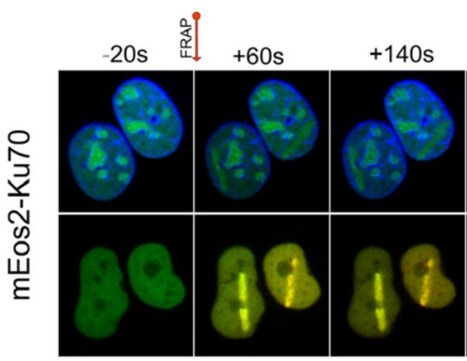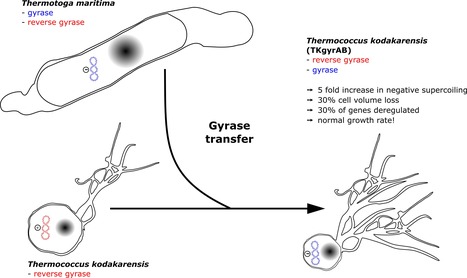 Your new post is loading...
 Your new post is loading...

|
Scooped by
I2BC Paris-Saclay
March 1, 2022 5:29 AM
|
The contribution of uncharted RNA sequences to tumor identity in lung cancer
Uncharted, unannotated RNAs contribute to cancer patient stratification and constitute novel theraputic targets. Cancer alters our RNAs in many ways, producing a wide diversity of aberrant RNAs of which many are specific to tumor types. Computational RNA sequence analysis in oncology typically focuses on specific RNA families such as mRNAs. Here we undertook to capture at once all RNAs found in lung cancer. To this aim we selected two lung cancer cohorts with 737 RNA sequence sets from lung biopsies, and we applied a technique called k-mer differential analysis, where we identify all RNA fragments that are either over or under-expressed in tumors. We then focused on fragments that were not previously known (uncharted RNAs) and reproducibly observed in both cohorts. Here is what we found:
– Uncharted RNAs come from many different locations (introns, intergenic regions, repeats) and in many forms (spliced, polyadenylated, chimeric etc.)
– A limited set of hypervariable genes such as immunoglobulins contribute a large amount of uncharted RNAs
– Uncharted RNAs from human retroelements define patient subclasses with distinct clinical and genomic features, a well documented phenomenon in cancer
– several uncharted RNAs, including one from a lung bacterium, correlate with the presence of specific immune cells.
– A number of uncharted can be translated and produce tumor-specific antigens that could be targeted by anti-cancer drugs
We hope to convince readers that large amounts of non-reference RNAs of functional significance remain hidden in bulk RNA-seq data. More information: https://academic.oup.com/narcancer/article/4/1/zcac001/6519484?searchresult=1 Contact: Daniel Gautheret <daniel.gautheret@i2bc.paris-saclay.fr>

|
Scooped by
I2BC Paris-Saclay
March 1, 2022 5:06 AM
|
HubP-dependent cell pole organization in Vibrio cholerae
By comparative proteomics we identified several novel proteins localize to the cell pole in Vibrio cholerae. Characterization of these proteins revealed an ever more versatile role for the landmark cell pole organizer HubP and identify novel mechanisms of motility regulation. Cell polarity is the result of controlled asymmetric distribution of protein macrocomplexes, genetic material, membrane lipids and cellular metabolites, and can play crucial physiological roles not only in multicellular organisms but also in unicellular bacteria. In the opportunistic cholera pathogen Vibrio cholerae, the polar landmark protein HubP tethers key actors in chromosome segregation, chemotaxis and flagellar biosynthesis and thus converts the cell pole into an important functional microdomain for cell proliferation, environmental sensing and adaptation between free-living and pathogenic life-styles. Using a comparative proteomics approach, we here-in present a comprehensive analysis of HubP-dependent cell pole protein sorting and identify novel HubP partners including ones likely involved in cell wall remodeling (DacB), chemotaxis (HlyB) and motility regulation (MotV and MotW). Unlike previous studies which have identified early roles for HubP in flagellar assembly, functional, genetic and phylogenetic analyses of its MotV and MotW partners suggest a direct role in flagellar rotary mechanics and provide new insights into the coevolution and functional interdependence of chemotactic signaling, bacterial motility and biofilm formation. This work was done in collaboration of Petya Krasteva team, former in B3S Dept of I2BC currently in IECB Bordeaux. More information: https://journals.plos.org/plosgenetics/article?id=10.1371/journal.pgen.1009991 Contact: Yoshi Yamaichi <yoshiharu.yamaichi@i2bc.paris-saclay.fr>

|
Scooped by
I2BC Paris-Saclay
March 1, 2022 4:58 AM
|
Kinetics of electron returns in the two-photon DNA repair by (6-4) photolyase
DNA repairing enzymes photolyases are ubiquitous natural catalysts using sunlight to revert cancerogenic chemical changes in DNA caused by UV light. The 3P Team Photobiology, Photosynthesis, Photocatalysis from the Institute of Integrative Biology of the Cell (I2BC) explores the molecular mechanism by which these essential photoenzymes have been repairing DNA since the beginnings of life evolution on Earth. In their latest work published in the journal ACS Catalysis, the researchers have shown that the repair of the UV-induced lesions called ‘(6-4) photoproducts’ occurs in two successive photoreactions (requiring absorption of two separate photons), each beginning with electron transfer from the excited flavin to the lesion. Transient absorption spectroscopy (https://www.pluginlabs-universiteparissaclay.fr/fr/entity/a5ad9e5d-53a4-4194-8653-3d8feebfafc8/i2bc-plateforme-de-spectroscopies-electroniques) was used to follow the return of electrons to the flavin after chemical transformations of the lesion. The team was able to dissect the electron return kinetics finalizing the first and the second photoreactions (in ~40 μs and ~200 ns, respectively), corroborating and detailing the two-photon reaction model. More information: https://doi.org/10.1021/acscatal.2c00492 Authors: Klaus Brettel, Pavel Müller (I2BC) and Junpei Yamamoto (Osaka University). The project was funded by the French National Research Agency (ANR). Contact: Pavel Müller <pavel.muller@i2bc.paris-saclay.fr.>

|
Scooped by
I2BC Paris-Saclay
February 21, 2022 8:59 AM
|
dnaJ: a New Approach to Identify Species within the Genus Enterobacter.
We propose a new approach for Enterobacter species identification based on the diversity of the gene encoding the heat shock protein DnaJ. This new tool can be easily implemented in clinical laboratories in addition to identification by MALDI-TOF. The taxonomy of the genus Enterobacter can be confusing and has been considerably revised in recent years. We propose a PCR and amplicon sequencing technique based on a partial sequence of the dnaJ gene for species assignment consistent with DNA-DNA digital hybridization (dDDH) and pairwise average nucleotide identity (ANI).We performed a validation of the method by comparing the type strains of each species, sequences obtained from the GenBank database, and clinical specimens. Our results show that the polymorphism of the target sequence of dnaJ allows the identification of species. Using this gene, we assigned the species to 100 strains deposited in the GenBank database that were consistent with the species assignment by dDDH and ANI. The analysis showed that using the partial dnaJ sequence is congruent with WGS as far as correct identification of Enterobacter species is concerned. Finally, we applied our dnaJ method on a national collection of 68 strains identified as Enterobacter isolated from the blood cultures of premature babies using an algorithm based on a type strain library and the SeqScape® software. For the first time, we identified Enterobacter quasihormaechei in blood cultures from four neonatal sepsis cases. We also noticed a higher prevalence of E. bugandensis (36.3%; 32/88) and E. xiangfangensis (46.5%; 41/88). E. bugandensis is a novel species recently described specifically in instances of neonatal sepsis. In conclusion, sequencing a part of the dnaJ gene could be a quick, more economical, and highly discriminating method of identifying Enterobacter species in clinical practice and research. More information here. Contact person: Nadege Bourgeois-Nicolaos

|
Scooped by
I2BC Paris-Saclay
February 21, 2022 8:45 AM
|
The strange case of Drp1 in autophagy: Jekyll and Hyde?
Chen et al. review the roles of Drp1, a GTPase essential for mitochondria fission but whose functions during autophagy are controversial. They speculate on its non-canonical functions and the prerequisite of the reduction of mitochondria size during mitophagy. There is a debate regarding the function of Drp1, a GTPase involved in mitochondrial fission, during the elimination of mitochondria by autophagy. A number of experiments indicate that Drp1 is needed to eliminate mitochondria during mitophagy, either by reducing the mitochondrial size or by providing a non-canonical mitophagy function. Yet, other convincing experimental results support the conclusion that Drp1 is not necessary. Chen et al. review herethe possible functions for Drp1 in mitophagy and autophagy, depending on tissues, organisms and stresses, and discuss these apparent discrepancies. In this regard, it appears that the reduction of mitochondria size is often required for mitophagy but not always in a Drp1-dependent manner. Finally, we speculate on Drp1-independent mitochondrial fission mechanism that may take place during mitophagy and on non-canonical roles, which Drp1 may play such as modulating organelle contact sites dynamic during the autophagosome formation. More information here. Contact person: Renaud LEGOUIS

|
Scooped by
I2BC Paris-Saclay
February 21, 2022 8:28 AM
|
Rectifying function of electron relays finally unravelled in a photo-synthetic model
Nature’s trick in conversion of light into chemical energy is revealed when an artificial photo-synthetic model showed evidence of intermediate state pertaining to functionality of electron relay in controlling unidirectional flow and accumulation of charges. In photosynthesis, Photosystem II is the enzyme that captures sunlight to drive the four-electron, four-proton oxidation of water. It contains a series of co-factors in a defined setup to convoy electrons in a vectorial fashion from the initial locus of light excitation to accumulate charges at the catalytic unit. A pair of Tyr and His amino acids plays a decisive role as relay between the P680 chlorophyll, the primary photooxidant, and the Mn4Ca water oxidizing catalyst (WOC) as it couples the one-photon, one-electron photochemistry of the light absorber to multi-electronic catalysis. A “rocking proton” mechanism operating between these two residues has been identified as a crucial feature of this electron relay. Implementing such functionalities in chemical modular assemblies may help chemists to gain control over the directionality of electron transfer when developing molecular systems for artificial photosynthesis.
Gotico et al. have investigated a set of molecular triads holding a photosensitizer, an imidazole as redox relay, and a monometallic manganese complex as a proxy for a WOC. Time-resolved spectroscopy coupled with the electrochemical properties has permitted to track the formation of an imdazolyl radical, initiated from the photooxidized chromophore, and its subsequent decay connected to oxidation of the Mn(II) site. Comprehensive analysis of the thermodynamic and kinetic parameters reveal the importance of the acid-base properties of this electron relay and highlight the crucial role of reversible proton transfer to allow the system to display a light-induced two-step electron hopping process. This study sets the path for further optimization in the directional electron transfer and charge accumulation for using photons to drive the oxidation of water. More information here. Contact person: Winfried LEIBL

|
Scooped by
I2BC Paris-Saclay
February 21, 2022 7:47 AM
|
3-days Training in Flow Cytometry
Imagerie-Gif and CNRS Formation Entreprises are organizing a training to blow your mind with flow cytometry. We offer you to acquire the theoretical bases in flow cytometry (analysis and sorting, experimental strategies), to be informed of applications and developments in very varied fields of application, and to initiate or deepen the use of analyzers and sorters.
The training will be split in theoretical mornings and practical afternoons. Practical afternoons will take place on GIF and ORSAY campus.
The training is opened to Student, researcher and Engineer. https://cnrsformation.cnrs.fr/atelier-cytometrie?mc=Cytom%C3%A9trie Contact person: BOURGE Mickael

|
Scooped by
I2BC Paris-Saclay
January 25, 2022 5:46 AM
|
First ICNS/I2BC Morning-Meeting February 8th at 9.30 a.m
The ICSN and the I2BC are the two major units of the CNRS campus of Gif sur Yvette. The “institut de Chimie des substances naturelles” (ICSN), with a staff of nearly 150 people, is the chemistry pole of the CNRS campus in Gif sur Yvette. This unit develops activities at the chemistry-biology interface, with natural substances as the object of study and main source of inspiration. Equipped with numerous platforms, including two NMR platforms, the ICSN will host an NMR apparatus from an I2BC team when it moves from the CEA-Saclay to the Gif-sur-Yvette campus. However, the links between our two institute are not limited to NMR; the purpose of this first morning is to introduce you to ICSN in the hope of encouraging new collaborations. This first Morning-Meeting, which will be the first of a series, will be oriented towards the platforms of the two units and duos of researchers to illustrate the fruitful collaborations already in place. Please come in large numbers to meet your chemical colleagues. Due to health conditions, the meeting will be held in hybrid mode, both in the auditorium of Building 21 on the Gif-sur-Yvette campus and on Zoom. See program on the website: here Contact for link: communication@i2bc.paris-saclay.fr

|
Scooped by
I2BC Paris-Saclay
January 13, 2022 5:22 AM
|
appelsprojetsrecherche.fr est un portail à destination des acteurs de la recherche. Inscrit dans le cadre de la Loi de Programmation de la Recherche, il est porté aujourd’hui par six partenaires : l’Ademe, l’ANR, l’ANRS, l’ANSES, l’INCa et l’Inserm. Il offre ainsi un accès unifié aux appels à projets ou à candidatures à venir et en cours, pour une plus grande visibilité de l’offre de financement. Après la date de clôture, les appels restent publiés encore quelques mois.

|
Scooped by
I2BC Paris-Saclay
January 13, 2022 5:14 AM
|
BSI 2021: one week with intensive scientific discussions!
The 2nd french congress on integrative structural biology took place on november29th-December 3rd at the Centrale Supelec building, located on the Paris- Saclay plateau. Co-organized by the Association Française de Cristallographie and the Société Française de Biophysique, it brought together over 250 participants of which 63 students. The program of the event included 13 sessions covering health issues, DNA/RNA world, membrane proteins, intrinsically disordered proteins, macromolecular assemblies. Several round tables allowed discussions about “formation tout au long de la vie”, ” interactions entre académie/industrie”, ” infrastructures” and “la parole scientifique dans l’espace public”. A satellite event on the revolutionnary tool AlphaFold ended up the congress. Many thanks to the institutional partners (CNRS, CEA, I2BC, ICSN, Ecole Polytechnique, ENS Paris-Saclay, FRISBI, IRRMN, Université Paris-Saclay , Université Paris-Saclay Graduate School Life Sciences and Health, Synchrotron SOLEIL, France-Bioimaging) and industrial partners (Bruker, Cytiva, CytobodX, Dynamic Biosensors, Eurisotop, GenScript, Horiba, Innova-Chem, Jeol, NMR-Bio, Refeyn, Sanofi, Servier, Sptlabtech , Thermofisher, et Twist ) for their support. Congratulations to Magda Teixeira Nunes and and Luce Dreno who won the best poster prize of the AFC and SFB, respectively! BSI website Contact person: Julie Ménétrey

|
Scooped by
I2BC Paris-Saclay
January 13, 2022 5:04 AM
|
"Blue" is the new I2BC PhD class
This fall, the I2BC welcomed its 36 new doctoral students on December 13, 2021. 2020-21 was the the “white” class, 2021-22 is the”blue” class. After a presentation by Frederic Boccard on the research fields of I2Bc and its technological platforms, the doctoral students were able to meet YourI2BC, the association of young researchers from I2BC. the association organizes social and scientific events throughout the year, mainly aimed at young researchers from the I2BC. The “Blue Class” is made up of 36 new doctoral students in six doctoral schools of the University of Paris-Saclay, the two main ones being ED 577 (structure and dynamics of living systems) and ED 569 (therapeutic innovation). Despite the difficulties encountered since the start of the COVID-19 pandemic, 13 students come from abroad. Finally, the doctoral students are divided into teams belonging to the 5 disciplinary departments of the I2BC: 10 doctoral students in each of the B3S, Genome Biology and Microbiology departments and 4 and 2 doctoral students in the Cellular Biology and Virology departments respectively.
Welcome to the new PhD class of I2BC! More information : YourI2BC

|
Scooped by
I2BC Paris-Saclay
December 20, 2021 5:12 AM
|
Emmanuelle Quemin as new group leader in the I2BC Virology department : Replication and assembly of poxviruses
Emmanuelle Quemin was selected by an ad hoc international committee organized by the I2BC Scientific Advisory Board. Recently hired at the CNRS as a researcher, she has just joined the department of Virology to create her own reasearch team called “Replication and assembly of poxviruses”. Trained as a microbiologist and geneticist, she obtained her thesis in 2015. After a first postdoctoral internship at the Pasteur Institute, she left for Hamburg to work in the laboratory of Professor K. Grünewald. Her research projects aim to provide new information on virus-host interactions and to understand the molecular mechanisms of cell membrane remodeling associated with viral entry, replication, assembly and degradation. In particular, she will study the vaccinia virus. Welcome and success to Emmanuelle Quemin. Team Replication and assembly of poxviruses

|
Scooped by
I2BC Paris-Saclay
December 20, 2021 4:49 AM
|
A non-canonical autophagy is involved in the transfer of Plasmodium-microvesicles to astrocytes
Towards a therapy against cerebral malaria? Cerebral malaria is a neuroinflammatory disease caused by the parasite Plasmodium falciparum. Dr Sylviane Pied's team at the Center of Infection and Immunity of Lille (Inserm U1019-CNRS UMR9017) in collaboration with that of Dr Stanistlas Tomavo, Institute for Integrative Biology of the Cell (CNRS UMR 9198-CEA, Université Paris Saclay) identified an original mechanism explaining the disease. Researchers have shown that the transfer of parasitic microvesicles to astrocytes occurs through an unconventional autophagy mechanism and causes these cells to malfunction. Astrocytes are well known for their role in the integrity of the blood brain barrier. Using a preclinical model and pharmacological drugs, the researchers succeeded in inhibiting the entry of parasitic microvesicles into astrocytes. Thus, the function of astrocytes is restored during infection leading to protection against cerebral malaria. This major discovery could have applications in humans. The results of this study were published in the journal Autophagy. 2021 Nov 6:1-16. doi: 10.1080/15548627.2021.1993704. PMID: 34747313. More information here. Contact person: Stanislas Tomavo
|

|
Scooped by
I2BC Paris-Saclay
March 1, 2022 5:25 AM
|
Precipitation of greigite and pyrite induced by Thermococcales: an advantage to live in Fe- and S-rich environments?
The diverse metabolic pathways and biologically induced mineralization mechanisms employed by Thermococcales would thus help them to survive in a broad range of extreme environments characterized by the high temperatures and high iron and sulfide contents. Thermococcales, a major order of archaea inhabiting the iron- and sulfur-rich anaerobic parts of hydrothermal deep-sea vents, have been shown to rapidly produce abundant quantities of pyrite FeS2 in iron–sulfur-rich fluids at 85°C, suggesting that they may contribute to the formation of ‘low temperature’ FeS2 in their ecosystem. We show that this process operates in Thermococcus kodakarensis only when zero-valent sulfur is directly available as intracellular sulfur vesicles. Whether in the presence or absence of zero-valent sulfur, significant amounts of Fe3S4 greigite nanocrystals are formed extracellularly. We also show that mineralization of iron sulfides induces massive cell mortality but that concomitantly with the formation of greigite and/or pyrite, a new generation of cells can grow. This phenomenon is observed for Fe concentrations of 5 mM but not higher suggesting that above a threshold in the iron pulse all cells are lysed. We hypothesize that iron sulfides precipitation on former cell materials might induce the release of nutrients in the mineralization medium further used by a fraction of surviving non-mineralized cells allowing production of new alive cells. This suggests that biologically induced mineralization of iron-sulfides could be part of a survival strategy employed by Thermococcales to cope with mineralizing high-temperature hydrothermal environments. More information: https://sfamjournals.onlinelibrary.wiley.com/doi/full/10.1111/1462-2920.15915 Contact: Aurore Gorlas <aurore.gorlas@i2bc.paris-saclay.fr>

|
Scooped by
I2BC Paris-Saclay
March 1, 2022 5:03 AM
|
Multiplexed Biosensing and Bioimaging Using Lanthanide -Based Time-Gated Förster Resonance Energy Transfer
The necessity to scrutinize biological molecules and their interactions in solution and on the cellular level leads to an increasing demand for specific diagnostic analysis. FRET is ideally suited for multiplexed biosensing because it is rapid and sensitive and allows the use of any fluorescent probe. The most frequently used technique to detect multiple parameters from a single sample is color multiplexing with different fluorophores. In conventional biosensing approaches, each fluorophore requires a distinct detection channel and excitation wavelength. This drawback can be overcome by Förster resonance energy transfer (FRET) from lanthanide donors to other fluorophore acceptors. The lanthanide multiple and spectrally narrow emission bands over a broad spectral range can overlap with several different acceptors at once, thereby allowing FRET from one donor to multiple acceptors. Their extremely long lifetimes provide two important features: efficient suppression of background from the biological environment using time-gated (TG) detection and detection of specific biomolecules and/or their conformation using temporal multiplexing. Applications range from fundamental analysis of biomolecular interactions and conformations to high-throughput and point-of-care in vitro diagnostics and DNA sequencing to advanced optical encoding, using both liquid and solid samples and in situ, in vitro, and in vivo detection with high sensitivity and selectivity.
In this Account, we discuss recent advances in lanthanide-based TG-FRET for the development and application of advanced immunoassays, nucleic acid sensing, and fluorescence imaging. We highlight the importance of the careful design and combination of different biological, organic, and inorganic molecules and nanomaterials for an adjustable FRET donor–acceptor distance that determines the ultimate performance of the diagnostic assays and conformational sensors in their physiological environment. We conclude by sharing our vision on how progress in the development of new sensing concepts, material combinations, and instrumentation can further advance TG-FRET multiplexing and accelerate its translation into routine clinical practice and the investigation of challenging biological systems. More information: https://pubs.acs.org/doi/10.1021/acs.accounts.1c00691 Contact: Marcelina Cardoso dos santos <marcelina.cardoso-dos-santos@i2bc.paris-saclay.fr>

|
Scooped by
I2BC Paris-Saclay
February 21, 2022 9:09 AM
|
New member has joined the Programmed Genome Rearrangement Team in I2BC Genome Biology Department.
My name is Valerio VITALI, I am a new Italian postdoc in the Programmed Genome Rearrangement Team (Bétermier Lab) since Feb 1st. Under the guidance of Mireille—and in close collaboration with the team—I am tasked to design and implement creative strategies to characterize the complex machinery that catalyzes developmentally programmed DNA rearrangements in Paramecium (removal of intervening sequences coupled with DNA repair).
I have received my PhD in Evolutionary Genomics and Bioinformatics from the University of Münster (WWU), Germany. While at the Institute for Evolution and Biodiversity, my research has focused on the highly plastic genome architecture of Paramecium, and its evolutionary potential. During my doctoral and (brief) post-doctoral research, I have gained transferable experience in comparative genomics and trancriptomics, single cell whole-genome sequencing, and the analysis of Structural Variants (SVs) from NGS data.
When not in the Lab, I enjoy running, reading books about evolution and aging, learning new languages (or at least trying!) and cooking traditional meals.
I am excited to have joined the Genome Biology Department at the I2BC and can't wait to greatly expand my knowledge of Genome and Cell Biology, Biochemistry, Biophysics, Structural biology.....and beyond. GitHub Profile: https://github.com/biowalter/senes Full list of Publications: https://scholar.google.com/citations?hl=en&user=BI3IdwwAAAAJ

|
Scooped by
I2BC Paris-Saclay
February 21, 2022 8:54 AM
|
STÉPHANIE BURY MONÉ: REVEALING THE HIDDEN POTENTIAL OF BACTERIA

|
Scooped by
I2BC Paris-Saclay
February 21, 2022 8:41 AM
|
A new RNA–DNA interaction required for integration of group II intron retrotransposons into DNA targets
A novel structural device used by bacterial retrotransposons to efficiently invade host genomes was identified. These results will also contribute to the rational design of new RNA-based gene targeting systems for bacterial genome engineering. Mobile group II introns are site-specific retrotransposable elements widespread in bacterial genomes and in organelles (mitochondria and chloroplasts) of plants, algae and fungi. They constitute the most abundant class of retrotransposons in bacteria and play a major role in the diversification and evolution of bacterial genomes. Mobile group II introns are composed of a large and highly structured self-splicing intron and an intron-encoded reverse transcriptase. They colonize genomes by 'Retrohoming', a very efficient and specific pathway that is operated by the combined activities of the self-splicing intron and its reverse transcriptase. During the first stage of mobility, the intron RNA catalyzes its own insertion directly into the DNA target site. Recognition of the proper target rests primarily on multiple base pairing interactions between the intron segments ‘EBS’ and complementary 'IBS' sequences present on the double-stranded DNA target (Figure 1A). Remarkably, the sequence of the EBS sites can be modified, thus allowing to 'reprogram' a group II intron to specifically integrate into a desired DNA target. This feature is at the basis of the powerful 'Targetron' technology, now commonly used for bacterial genome engineering. Using bioinformatics and genetic approaches, Maria Costa and collaborators have identified a novel base pairing interaction between the intron RNA and the DNA target that is essential for intron mobility. This pairing, named 'EBS2a-IBS2a', adopts a Watson–Crick geometry and helps inducing a structural conformation that favors the opening of the DNA double helix and the integration of the retrotransposon into the genome (Figure 1B). The authors also showed that the EBS2a-IBS2a interaction is perfectly 'reprogrammable'. This work has direct biotechnological applications by allowing the development of new 'targetrons' capable of inserting themselves into genomic sites that were previously inaccessible to disruption by these systems. More information here. Contact person: Maria Costa

|
Scooped by
I2BC Paris-Saclay
February 21, 2022 8:20 AM
|
Cryo-EM platform reveals first images of phages discovered by students
I2BC teams collaborate and create a teaching project to discover new phages with Bachelor students from Université Paris-Saclay. Financed by a grant from the University Paris-Saclay to develop teaching innovation, lecturers from I2BC’s Virology and Microbiology Departments have created a new lab course unit, called “Phage Discovery”, for second-year Bachelor students.
In September 2021, thirteen “phage hunters” signed up for this elective course and collected soil and water samples from the campus of Orsay and surroundings. Following purification, they isolated three distinct viruses that infect the bacterium Corynebacterium glutamicum. The students were welcomed by the cryo-electron microscopy platform of I2BC by Ana Arteni, Laura Pieri and Malika Ould Ali. Student phage hunters were dazzled by electron micrographs of their phage samples. Their day at the platform was the highlight of their first research experience.
The project will continue after the sequencing of the viral DNA by the I2BC platform: third-year Bachelor students will annotate the phage genomes. Stay tuned!
Contact: Ombeline Rossier, Christophe Regeard

|
Scooped by
I2BC Paris-Saclay
February 21, 2022 7:38 AM
|
EMBO in-person workshop on Protein Termini in Bergen Norway 8-11 June 2022
EMBO in-person workshop on Protein Termini in Bergen Norway 8-11 June 2022
Here is the complete list of 32 confirmed speakers: 15-20 additional speakers will be selected from the abstracts.
Don't miss this chance to join world-leading PI in the beautiful city of Bergen.
Deadline 11 March 2022!
https://meetings.embo.org/event/21-protein-termini

|
Scooped by
I2BC Paris-Saclay
January 20, 2022 4:33 AM
|
Cryo-EM allows entering the fabulous nanometric world of peptide assemblies
The atomic structure of the nanotubes of Lanreotide, a therapeutic peptide, reveals a complexity that nothing allowed to suspect until now. Peptide assemblies forming hydrogels or fibrils are used for biomedical applications such as drug and vaccine formulation, cell culture and tissue regeneration. To enable the rational design of these self-assembled peptides, a thorough understanding of the chemical and physico-chemical rules guiding the folding and assembly of these molecules is required. With recent developments in cryo-electron microscopy (cryo-EM), the determination of these structures at the atomic scale has become possible. The study presented makes it possible to reveal by cryo-EM the atomic structure of nanotubes of a therapeutic peptide, Lanreotide. This structure is of a complexity that nothing allowed to suspect until now. These results are published in the journal PNAS. Functional and versatile nano- and micro-assemblies formed by biological molecules are found at all levels of life, from cellular organelles to complete organisms. Understanding the chemical and physico-chemical determinants guiding the formation of these assemblies is crucial not only to understand the biological processes that they implement but also to mimic nature through the rational design of self-assembled objects that can be used in particular biomedical level. These assemblies result from deterministic chemical interactions and are therefore all potentially predictable. But currently we simply lack the tools to predict how peptides assemble and the potentially polymorphic architectures they can form. To acquire predictive tools based on learning, we need to identify and understand a large number of peptide assembly structures. Among synthetic peptides forming well-defined nanostructures, the octapeptide Lanreotide has been considered one of the best characterized, both in terms of structure and self-assembly process. Lanreotide is a therapeutic peptide used against acromegaly and certain neuroendocrine cancers. This peptide self-assembles spontaneously in water in the form of nanotubes 24 nm in diameter and extremely long (around one mm), explaining the formation of a hydrogel. This hydrogel allows Lanreotide not only to be protected against chemical degradation but also to be released in a controlled manner over time (more than a month after injection) ensuring its continuous circulation in the blood. The detailed understanding of the chemical and physicochemical rules guiding the assembly of peptides would make it possible to design new controlled-release formulations in which, as in the case of Lanreotide, the drug would be its own formulation. Scientists elucidated the atomic structure of Lanreotide nanotubes obtained at a resolution of 2.5 Å by cryo-EM. This structure reveals a complexity that nothing let suspect in the many previous works and that it would have been impossible to predict by the methods we have today. The recent and phenomenal success of the artificial intelligence software AlphaFold for the prediction of the tertiary structure of proteins has only been possible thanks to the database of experimentally determined protein atomic structures. However, AlphaFold is not at this stage able to predict peptide folding and assembly. The experimental verification of models at a level of resolution close to the atom must therefore become the norm in this field. This will be an essential step towards the development of reliable predictive methods which will pave the way for the de novo design of peptide materials whose controlled properties will thus find applications in many fields of biology, pharmacy and medicine and may inspire developments in the field of nanotechnology. I2BC news Contact person: Maïté Paternostre Team Interactions and assembly mechanisms of proteins and peptides

|
Scooped by
I2BC Paris-Saclay
January 13, 2022 5:17 AM
|
Genome methylation dynamics in Sinorhizobium meliloti during symbiotic differentiation
Cell cycle regulating GANTC methylation patterns in the Sinorhizobium meliloti genome are remodelled during differentiation of this endosymbiont within plant cells, suggesting an epigenetic regulation of a bacterial differentiation process. In the rhizobium-legume symbiosis, the symbiotic bacteria are housed inside specific plant cells of root nodules where they fix nitrogen. These endosymbiotic rhizobia, called bacteroids, are metabolically differentiated and adapted to intracellular life. In legumes belonging to the genus Medicago, bacteroid differentiation of the symbiont Sinorhizobium meliloti involves also irreversible cellular modifications, including cell enlargement and genome amplification. By genome-wide DNA methylation analysis with SMRT-seq during the different stages of bacteroid differentiation in wild type plants as well as in a panel of plant mutants whose nodules contain endosymbionts blocked at various stages of differentiation, we obtained in this study evidence of dysregulated GANTC methylation patterns during bacteroid differentiation. We therefore propose that epigenetic control by the DNA methylase CcrM is a driving factor for the endoreduplication of the differentiated bacteroids. More information: https://doi.org/10.1128/mSystems.01092-21 Contact person: Peter Mergaert Team Plant-Bacteria Interactions

|
Scooped by
I2BC Paris-Saclay
January 13, 2022 5:08 AM
|
Clostridioides difficile – phage relationship the RNA way
In this review in Current Opinion in Microbiology special issue, we discuss recent insights into the role of RNAs in modulating interactions between the emerging human enteropathogen C. difficile and phages in light of intriguing data in other prokaryotes. Clostridioides difficile (formerly Clostridium difficile)-associated diarrhea is currently the most frequently occurring nosocomial diarrhea worldwide. During its infection cycle this pathogen needs to survive in phage-rich gut communities. Recent data strongly suggest that regulatory RNAs control gene expression in C. difficile and many of these RNAs appear to modulate C. difficile-phage interactions. Of the 200 regulatory RNAs identified by deep sequencing and targeted approaches, many function as antitoxins within type I toxin-antitoxin (TA) modules and CRISPR RNAs for anti-phage defenses. The purpose of this review is to give an overview of the RNAs contributing to the interactions of C. difficile with phages focusing on CRISPR-Cas and TA systems in light of intriguing recent data in other prokaryotes. We first describe what is known about the contribution of phages to C. difficile physiology and then highlight the recent findings on the emerging roles of RNAs in C. difficile-phage interactions. Open questions that arise from these first observations and future directions with potential roles of additional classes of regulatory RNAs are discussed. This increasing knowledge provides essential basis for future development of new molecular tools as well as promising diagnostic and therapeutic applications. More information: https://doi.org/10.1016/j.mib.2021.11.012 Contact person: Olga Soutourina

|
Scooped by
I2BC Paris-Saclay
December 20, 2021 5:17 AM
|
Phospho-Ku70 induced by DNA damage interacts with RNA Pol II and promotes the formation of phospho-53BP1 foci to ensure optimal cNHEJ
FRAP experiments with mEOS provide evidence of the essential role of the protein pKu70 in DNA repair. Canonical non-homologous end-joining (cNHEJ) is the prominent mammalian DNA double-strand breaks (DSBs) repair pathway operative throughout the cell cycle. Phosphorylation of Ku70 at ser27-ser33 (pKu70) is induced by DNA DSBs and has been shown to regulate cNHEJ activity, but the underlying mechanism remained unknown. Here, we established that following DNA damage induction, Ku70 moves from nucleoli to the sites of damage, and once linked to DNA, it is phosphorylated. Notably, the novel emanating functions of pKu70 are evidenced through the recruitment of RNA Pol II and concomitant formation of phospho-53BP1 foci. Phosphorylation is also a prerequisite for the dynamic release of Ku70 from the repair complex through neddylation-dependent ubiquitylation. Although the non-phosphorylable ala-Ku70 form does not compromise the formation of the NHEJ core complex per se, cells expressing this form displayed constitutive and stress-inducible chromosomal instability. Consistently, upon targeted induction of DSBs by the I-SceI meganuclease into an intrachromosomal reporter substrate, cells expressing pKu70, rather than ala-Ku70, are protected against the joining of distal DNA ends. Collectively, our results underpin the essential role of pKu70 in the orchestration of DNA repair execution in living cells and substantiated the way it paves the maintenance of genome stability. More information here. Contect person: Romain Le Bars

|
Scooped by
I2BC Paris-Saclay
December 20, 2021 4:59 AM
|
The hyperthermophilic archaeon Thermococcus kodakarensis is resistant to pervasive negative supercoiling activity of DNA gyrase
We show that DNA supercoiling can be flipped from positive to negative in the archeon Thermococcus kodakarensis without adverse effect for its growth. This archaeon seems to be remarkably resistant to such topological stress, in stark contrast to bacteria in which DNA supercoiling is tightly regulated by topoisomerases. In all cells, DNA topoisomerases dynamically regulate DNA supercoiling allowing essential DNA processes such as transcription and replication to occur. How this complex system emerged in the course of evolution is poorly understood. Intriguingly, a single horizontal gene transfer event led to the successful establishment of bacterial gyrase in Archaea, but its emergent function remains a mystery. To better understand the challenges associated with the establishment of pervasive negative supercoiling activity, we expressed the gyrase of the bacterium Thermotoga maritima in a naïve archaeon Thermococcus kodakarensis which naturally has positively supercoiled DNA. We found that the gyrase was catalytically active in T. kodakarensis leading to strong negative supercoiling of plasmid DNA which was stably maintained over at least eighty generations. An increased sensitivity of gyrase-expressing T. kodakarensis to ciprofloxacin suggested that gyrase also modulated chromosomal topology. Accordingly, global transcriptome analyses revealed large scale gene expression deregulation and identified a subset of genes responding to the negative supercoiling activity of gyrase. Surprisingly, the artificially introduced dominant negative supercoiling activity did not have a measurable effect on T. kodakarensis growth rate. Our data suggest that gyrase can become established in Thermococcales archaea without critically interfering with DNA transaction processes. More information here. Contact person: Tamara Basta
|
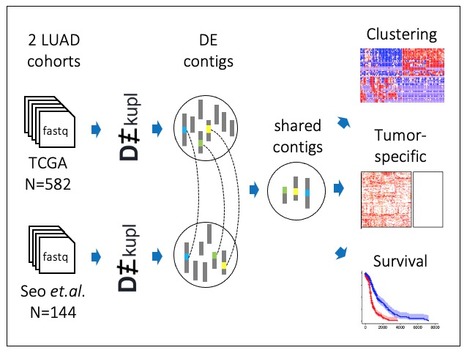



 Your new post is loading...
Your new post is loading...




